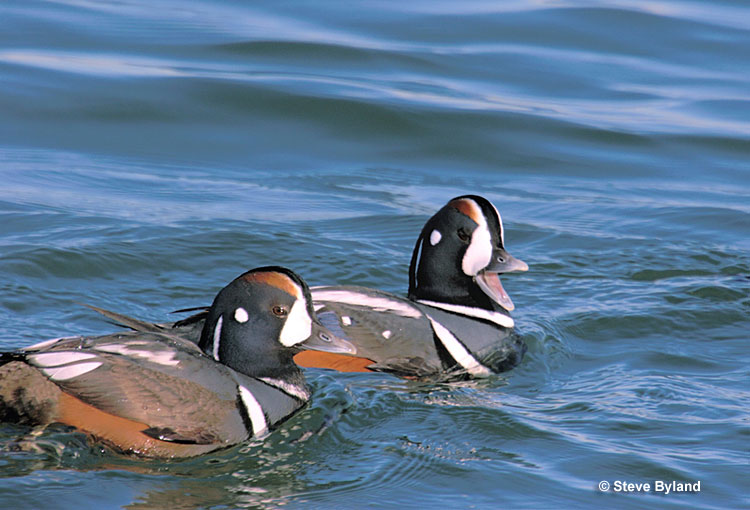
Ducks are fun birds to watch! They have beautifully patterned plumage, are easy to see, and occur in lots of places.
Alaska is one of the best places to see ducks! Lots of duck species live in this northern state including some that are hard to see elsewhere.
Have you seen many ducks in Alaska? We bet you’ve seen a lot but how many could you identify?
This list of the most common ducks in Alaska will help!
On this page
Alaska’s Duck Populations
In order to get the clearest view of the duck populations of Alaska, we focused on eBird data.
Alaska is a great place to see some rarer species you wouldn’t see in the lower states. While we only focused on the most common duck species, you can see Steller’s Eiders, King Eiders, Spectacled Eiders, Common Eiders, and some Eurasian species, such as Common Pochards, Stejneger’s Scoters, Smews, and Garganeys.
Mallard
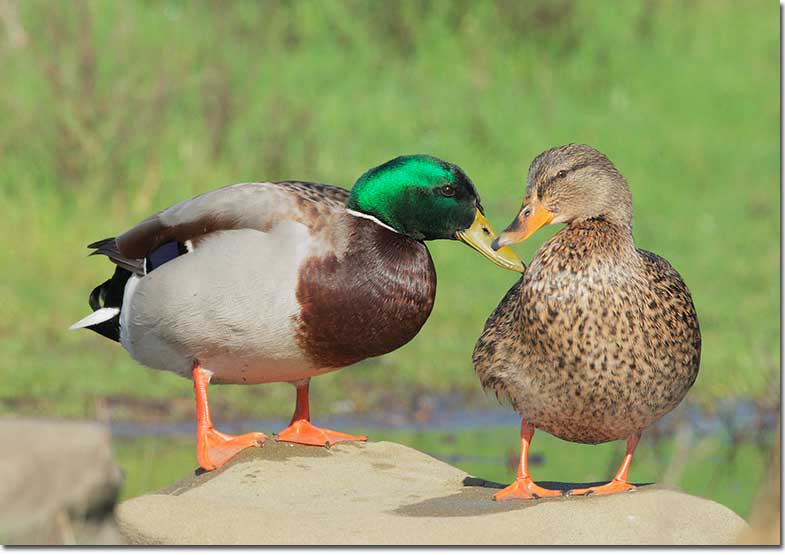
Scientific name: Anas platyrhynchos
Length: 23 inches
Wingspan: 35 inches
Mallards are the most familiar duck species. For lots of folks, this is “the duck”. They have been domesticated for centuries and lots of them are fed at urban ponds and lakes.
However, make no doubt about it, Mallards are wild birds that also live in lots of wild and remote areas in most of North America. The males have a dark green head, narrow white collar, yellowish beak, and dark brown chest.
Female Mallards, though, can be trickier to identify. They are brown with some paler brown and dark markings, and have a gray-brown neck and head with a dark cap, and a dark line through their eyes.
In flight, we can also recognize female Mallards by their pale tail, and two white wing bards bordering a green-blue wing patch.
Mallards stay in Alaska year-round and are easy to see on most bodies of water.
Key identifications:
- Big duck with a glossy green head and yellowish beak.
- The female has a dark center mark on her orange beak.
- Short, pale, or white tail.
Bufflehead
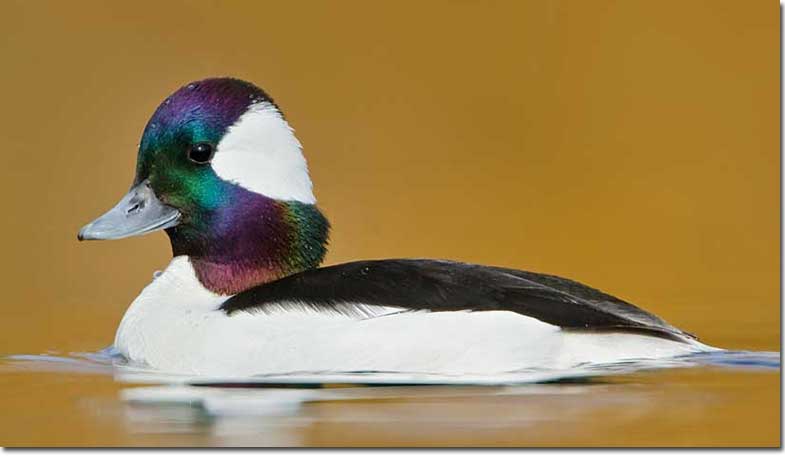
Scientific name: Bucephala albeola
Length: 13.5 inches
Wingspan: 21 inches
Buffleheads are small, cute ducks with rounded heads and stout little beaks. Males are bold, black and white birds with a big white patch on their head. In good light, their head also has green and purple iridescence.
Female Buffleheads are more gray-brown with a white belly, and have a smaller white head patch.
Related: Are bird range maps always accurate?
During their fast flight, Buffleheads show a white patch in their wings although the female’s white patch is smaller. These ducks breed on northern, forested lakes in Alaska, Canada, and parts of the northwestern USA. Like some other small ducks, they need tree cavities for nesting.
For the winter, they migrate to coastal waters and lakes, big rivers, and reservoirs.
Key identifications:
- Small chunky duck with stout gray beak.
- Rounded head with a bold white patch.
- Mostly black and white or grayish with a white belly and small white wing patch.
Harlequin Duck
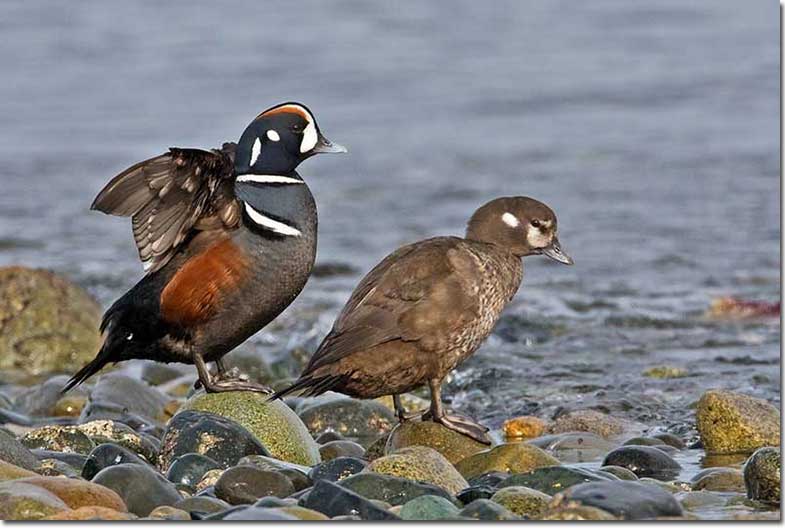
Scientific name: Histrionicus histrionicus
Length: 16.5 inches
Wingspan: 26 inches
Harlequin Ducks are small, unique ducks with small grayish beaks, and longish, pointed tails. Male Harlequins have ornamental plumage that resembles no other bird!
They are dark slaty gray with round and crescent-shaped white marks on their head and sides of their neck and chest. They also have some white marks where their wings meet their body, a bit of red-brown on their head, and red-brown sides.
Female Harlequins aren’t nearly as decorated. These dark brown ducks have a white belly, pale patch in front of their eyes, and a small round white spot on the side of their head.
These cute little ducks show all dark wings in flight, and forage for small aquatic creatures in cold, fast moving water. In summer, Harlequin Ducks breed along rivers in Alaska and western Canada south to Idaho, and in eastern Canada.
In winter, small flocks occur in similar fast water and coastal areas with rough surf conditions.
Key identifications:
- Dark gray with odd white patches.
- Dark brown with a round white spot on the side of the head (females).
- All dark wings in flight.
Common Merganser
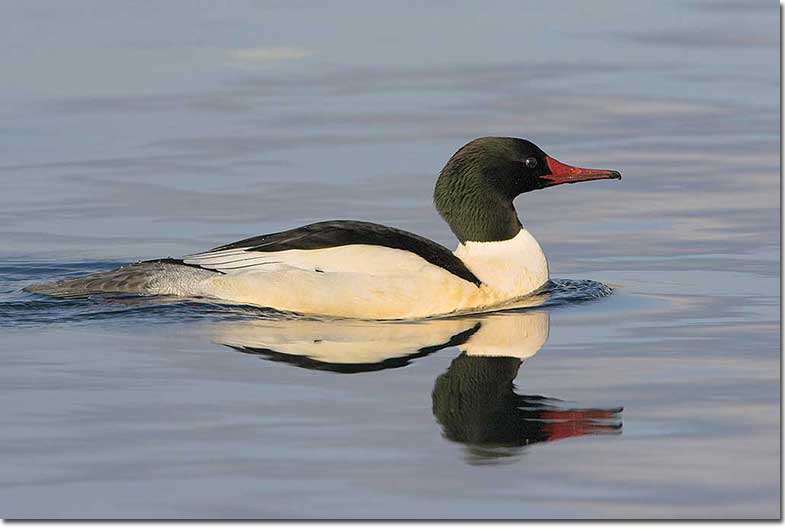
Scientific name: Mergus merganser
Length: 25 inches
Wingspan: 34 inches
Common Mergansers are big and slender ducks with pointed red beaks. Based on their size, the English name of “Goosander” for this bird seems fitting!
Breeding males are white with a dark green head and some black on their back and wings.
Female and nonbreeding male Common Mergansers are gray with a brown head, small white throat, and white on their belly. When flying, this species shows a lot of white on the base of their wings.
They have fast, direct flight and, after the breeding season, usually occur in small flocks.
These highly aquatic ducks catch fish and crustaceans after pursuing them underwater. They nest on cold lakes and rivers but, for winter migrate to more coastal areas.
However, they tend to be rare in the southeastern part of the country.
Key identifications:
- Red, pointed beak.
- Distinct brown head with a white throat.
- Males have all white underparts.
Common Goldeneye
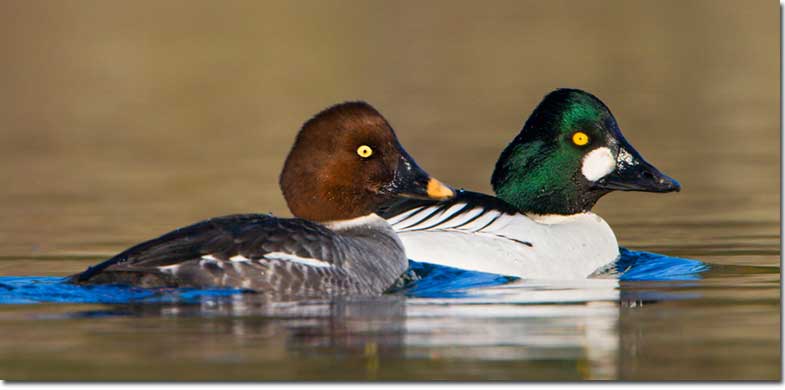
Scientific name: Bucephala clangula
Length: 18.5 inches
Wingspan: 26 inches
Common Goldeneyes are small ducks with a stout, triangular beak. Males are mostly white with some black markings and have green iridescence on their black heads. They also have a round white patch on their face.
Female Common Goldeneyes have gray bodies with a white belly, a pale collar, and a dark, gray-brown head. They also usually have a pale tip on their beaks.
Both sexes of this pretty little duck have pale eyes, and, in flight, show big white patches on the base of their wings.
Common Goldeneyes nest in tree cavities near lakes and other wetlands in forest from Alaska and Canada to parts of the northern USA.
After breeding, they form flocks that migrate to coastal areas, lakes, and other bodies of water, which is why you are more likely to spot them during winter months.
Key identifications:
- Small duck with a fairly large, stout blackish beak, and pale eyes.
- Male is black and white with a round white mark on his green-black face.
- Female has mostly gray body with a dark brown head.
American Wigeon
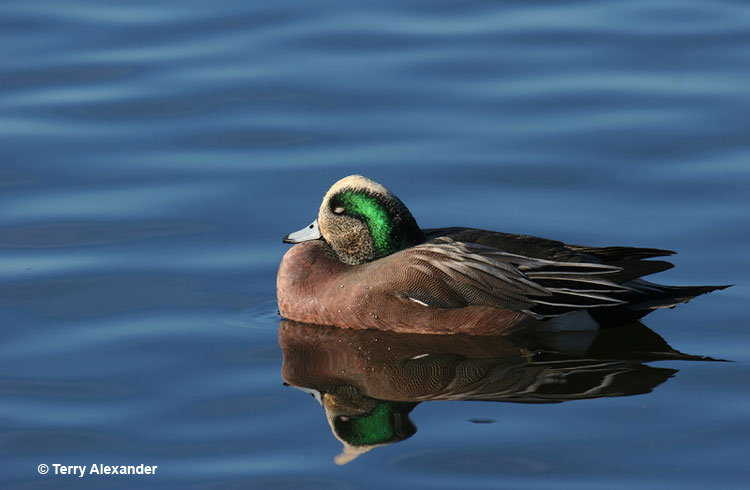
Scientific name: Mareca americana
Length: 20 inches
Wingspan: 32 inches
American Wigeons are medium-sized ducks with a smallish gray beak. Males are gray with a white crown, some dark green near their eyes, and peach-brown colors on their chest and sides.
They also have a black undertail and show white shoulders in flights. Females look like males but lack white and green on their heads and are a bit duller in general. Both sexes have pointed tails and a white belly especially visible in flight.
American Wigeons like to graze grass and eat grain while walking at the edge of wetlands and in wet fields. They can also pick plant matter and small creatures from the surface of the water and even steal food from other ducks!
This waterfowl species breeds in cold, shallow marshes, and many of them stay for the winter.
Key identifications:
- Rather small pale gray beak.
- Peach or gray-orange chest and flanks.
- Male has a white crown and white shoulders, female has grayish head with a dark area around her eyes.
Barrow’s Goldeneye
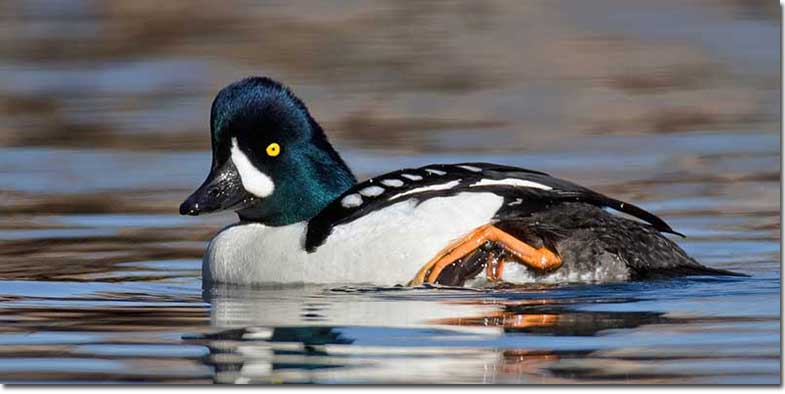
Scientific name: Bucephala islandica
Length: 18 inches
Wingspan: 28 inches
Barrow’s Goldeneyes are small diving ducks with blocky, square-shaped heads, and fairly stubby beaks. Males have black and white plumage with a white, crescent-shaped mark on their face, and small white spots on each side of their black back,
Female Barrow’s Goldeneyes are gray with a brown head, white belly, and yellowish bill. This species breeds on shallow ponds and lakes near forest, especially in highland areas from Alaska south to the northern Rocky Mountains. They also breed in Quebec and Iceland.
Barrow’s Goldeneyes nest in old woodpecker holes and other tree cavities in dead spruces and other conifers.
In winter, flocks of Barrow’s Goldeneyes forage for mussels and other aquatic creatures on the Pacific coast. These small ducks prefer shallow waters near rocky coasts, whereas the related and similar Common Goldeneye usually prefers deeper waters.
Key identifications:
- Blocky head with a stubby bill.
- Males have a white crescent-shaped mark on their face and small white spots on their black backs.
- Females have a stubby yellowish beak.
Red-breasted Merganser
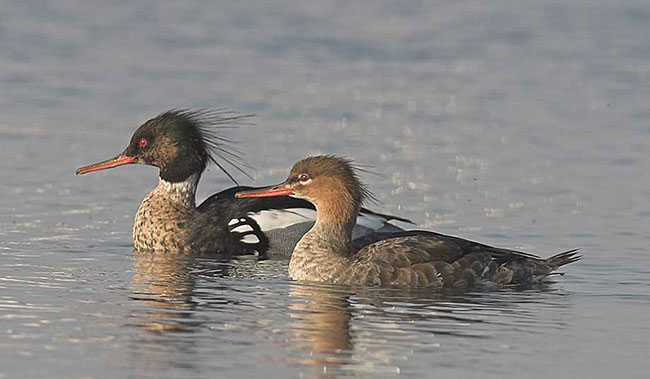
Scientific name: Mergus serrator
Length: 23 inches
Wingspan: 30 inches
Red-breasted Mergansers are big, slender ducks with long, thin beaks. Unlike some ducks we know, you won’t find them paddling around ponds and looking for handouts.
This duck is built for speed! Red-breasted Mergansers can fly at 80 miles per hour! They aren’t that fast when swimming underwater but are still quick enough to catch young trout and other fish.
Male Red-breasted Mergansers have a dark green head, broad white collar, and a dark brown chest border with black and white markings. They also have a black and white back, gray sides, and a white belly.
Females are mostly gray with a tawny head and a white belly. Both sexes have reddish beaks, a double crest, and white on the base of their pointed wings.
This duck species breeds on forested lakes and rivers.
Key identifications:
- Big, slender duck with a narrow reddish beak.
- Tawny or dark green head with a double crest.
- Much white on the base of long wings.
Surf Scoter
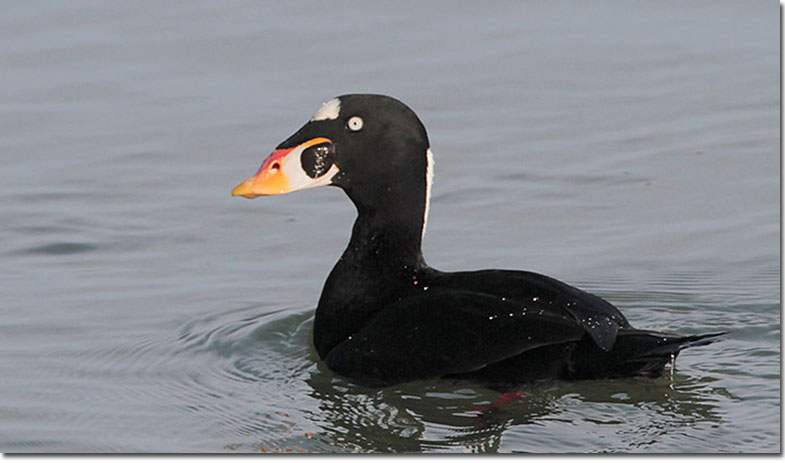
Scientific name: Melanitta perspicillata
Length: 20 inches
Wingspan: 30 inches
Surf Scoters are hefty, jet-black ducks with a big swollen beaks, especially the males. Their large beaks are white, orange, and red, and have a big round black spot!
The male’s other main field marks are a small white patch on the front part of the crown and a big white patch on the back of the neck.
Both sexes of the Surf Scoter also have staring white eyes! However, female Surf Scoters aren’t as fancy. They are dark gray-brown, have a dark cap, and some pale marks on their head.
Young birds have more pronounced white patches on their head, and an extensive whitish belly.
Surf Scoters fly fast, low over the water, and have all-dark wings. They dive for mollusks and other small creatures in cold, northern lakes and coastal waters.
They are easy to spot during the winter.
Key identifications:
- A beak with a swollen appearance.
- Dark wings in flight.
- White line at the base of the bill.
Northern Pintail
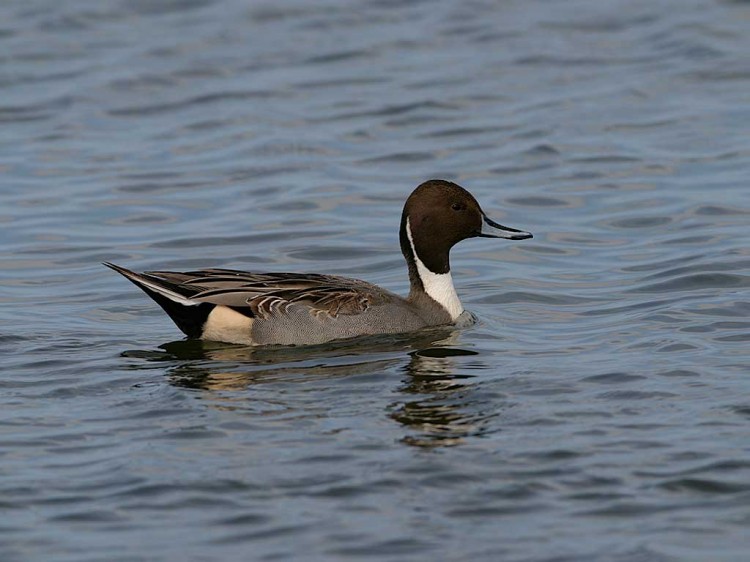
Photograph © Sam Crowe.
Scientific name: Anas acuta
Length: 21 inches
Wingspan: 34 inches
Northern Pintails are fairly large and slender, gray and creamy white ducks with long necks, and long tails. Breeding males are handsome birds with dark, chocolate-brown on their head and neck, a black undertail, and a long pointed tail feather.
Females and nonbreeding males are gray and tawny birds with a plain, pale tawny head and neck, and a gray beak. In flight, Northern Pintails also show long, pale gray wings, and the males have a dark green patch on the base of each wing.
We see these neat ducks in shallow marshes, and on lakes and other wetlands. They often form small groups that can flock with other waterfowl species.
They forage for grains and small aquatic creatures by dabbling in very shallow water and picking food from the wet ground while walking at the edge of the water, and in wet fields.
You can start seeing more of them in April, but if you are lucky, you can see them throughout the year!
Key identifications:
- Fairly large duck with a long, slender neck.
- Pointed tail.
- Dark brown or tawny head and a gray beak.
Green-winged Teal
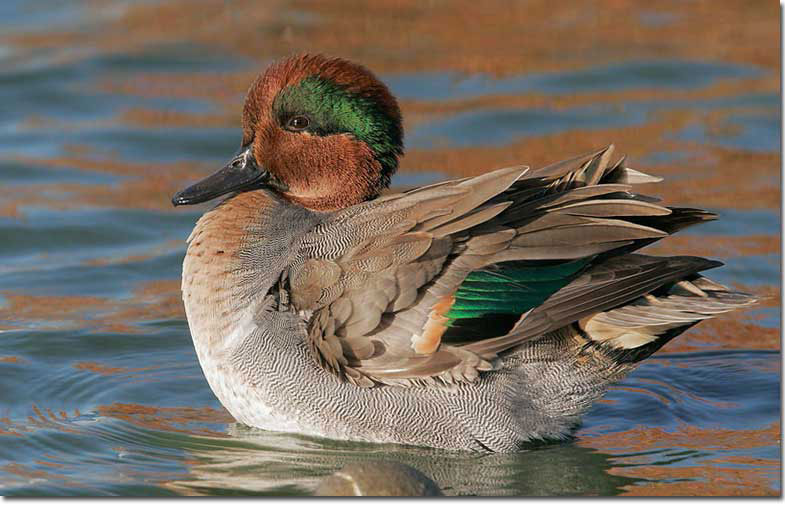
Scientific name: Anas crecca
Length: 14 inches
Wingspan: 23 inches
Green-winged Teals are small waterfowl with a smallish, dark beak, and a dark green patch at the base of each wing. Males of these cute little ducks are mostly gray and have a chestnut head with a dark green patch, speckled, buff chest, and narrow white bar near their chest.
Females are mostly mottled brown with a dark line through each eye. Both sexes have a buff mark on the edge of their tail, and show a white belly in flight. Green-winged Teal like to forage for plants and small creatures in the shallow water of marshes and other wetland habitats.
Green-winged Teals are easier to spot during the breeding season and when they migrate. Some birds stay in Alaska for winter too!
Key identifications:
- Very small duck.
- Buffy mark along the edge of each side of its tail.
- Small dark beak and dark green patch edged with buff on its wings.
Long-tailed Duck
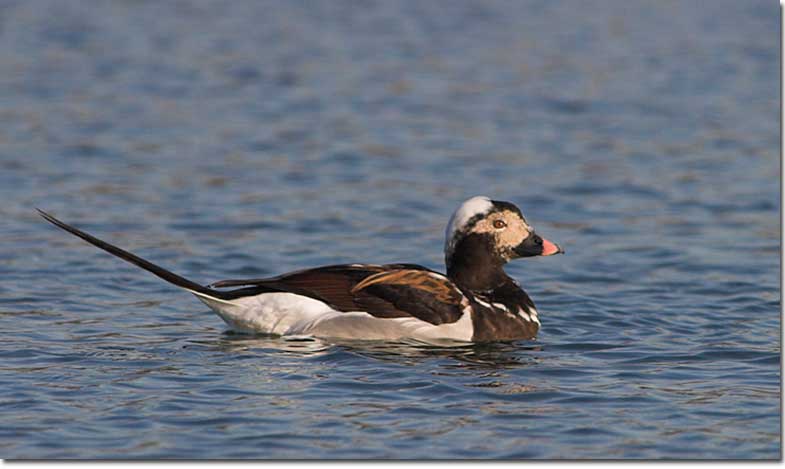
Scientific name: Clangula hyemalis
Length: 16.5 inches
Wingspan: 28 inches
Long-tailed Ducks are small pale ducks at home on cold, Arctic tundra lakes. Breeding males have smart-looking, black plumage with a pale gray face patch, white belly and sides, and some brown feathers on their back.
They also have long, black central tail feathers! However, since they live so far north, not a whole lot of people get to see them in their breeding plumage. Most male Long-tailed Ducks that birders see have much more white on their head, neck, and chest, and silvery feathers on their backs.
Females don’t look as exotic and lack the male’s long tail feathers but are still nice to see! They are gray-brown with white on their head, belly, and undertail.
Both sexes have fairly broad black wings and forage for small aquatic animals by diving underwater. These small ducks breed on ponds and other wetlands and do not necessarily migrate to south.
Key identifications:
- White belly, dark chest, and broad, black wings.
- Small beak, and gray and white plumage with some black markings.
- Pointed tail (very long in male).
Greater Scaup
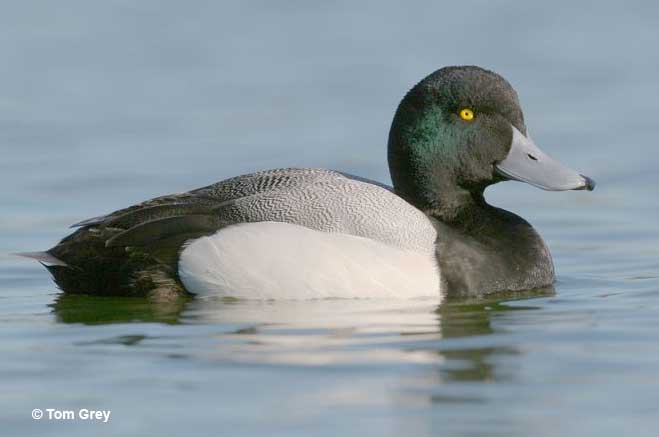
Scientific name: Aythya marila
Length: 18 inches
Wingspan: 28 inches
Greater Scaups are medium-sized ducks with pretty hefty, bluish beaks, and a rounded head with a pronounced forehead. Males have white bodies with pale gray backs, a blackish head with green iridescence, black chest, and black rump, tail, and undertail.
Female Greater Scaups are gray-brown birds that are darker brown on their heads, chest, and rear end. They also have a white patch on the front of their face. Both sexes also have pale eyes, and, in flight, show white bellies, and a broad white stripe on most of their wings.
Greater Scaups dive underwater to forage for mollusks and some other creatures.
They mostly nest in remote areas of Alaska and northern Canada and can be seen year-round.
Key identifications:
- Large, blue-gray beak with black tip.
- Rounded head that has a prominent projecting forehead.
- In flight, white stripe that nearly reaches the tip of the wing.
White-winged Scoter
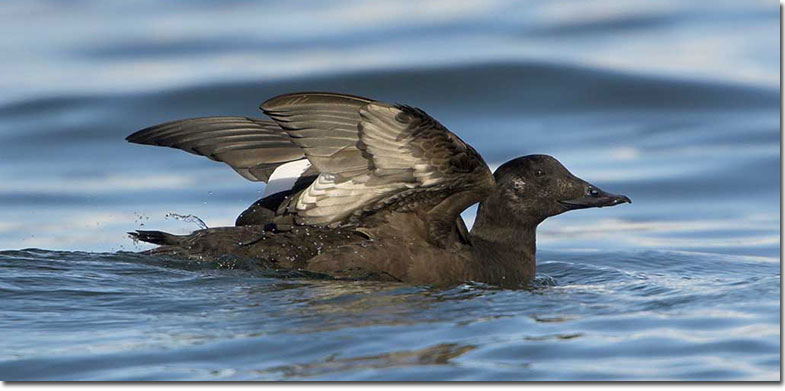
Scientific name: Melanitta deglandi
Length: 21 inches
Wingspan: 34 inches
White-winged Scoters are large, sooty black ducks with a big white patch on their wings. This white wing patch is the easiest way to identify them and is visible on flying birds pretty far away!
Males have a small white patch below their eyes, and a fairly large, orange-red beak. Female White-winged Scoters are also sooty black but have a dark beak, and two pale patches on their head. Juveniles resemble females but have whiter patches on their head and a pale belly.
These hefty ducks dive in large bodies of water and coastal waters to forage for mollusks and other small sea creatures.
Key identifications:
- Hefty black duck with white wing patches.
- Small white spot below each eye.
- Small, pale, round mark in front of their eyes (the female).
Black Scoter
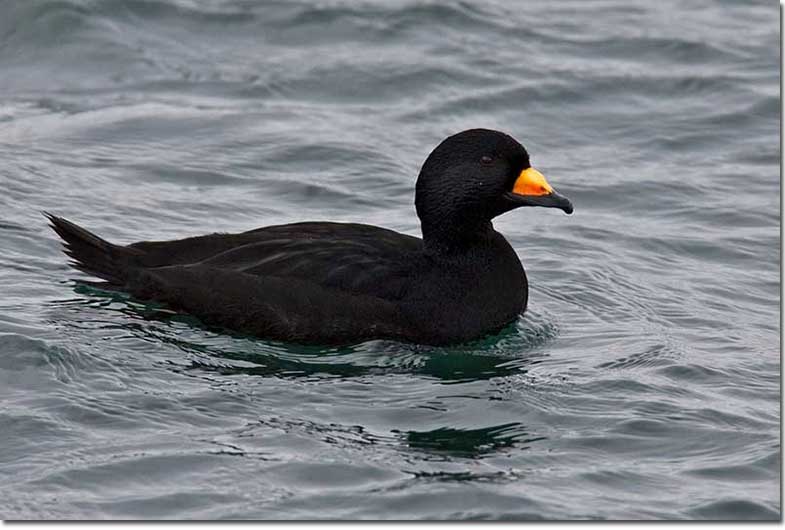
Scientific name: Melanitta americana
Length: 19 inches
Wingspan: 28 inches
Black Scoters are large, all black ducks with fairly large beaks. Males are entirely plush black but also have a big yellow knob on their bill. In flight, they also show slightly paler flight feathers that contrast with the rest of their darker wings.
Female Black Scoters don’t have any yellow on their beaks and look much duller. These birds are dark gray-brown with a blackish cap, and a pale face.
Black Scoters dive for mollusks and other small aquatic creatures in big lakes and coastal waters. In summer, pairs breed on fairly shallow lakes and most of them stay in Alaska throughout the year.
Key identifications:
- Heavy black duck with yellow on its beak (males).
- Dark duck with a dark cap and a pale face (females).
- All dark wings in flight.
FAQ
How many ducks are there in Alaska?
There are 40 species of ducks in Alaska. However, 12 of those species are rare visitors to the state.
Does Alaska have any sea ducks?
Alaska has several species of sea ducks ranging from scoters to different eiders.
Are ducks hunted in Alaska?
Yes, ducks are hunted in Alaska. They are hunted for food in many parts of the state.
Does Alaska have any duck species you can’t see in the lower states?
Alaska has a few duck species that are easier to see there than in the lower states. Several Eurasian species also wander to Alaska more often than to the lower states.
More in Alaska: Most common birds | State bird

